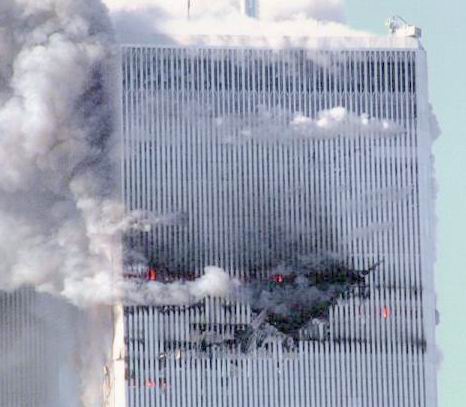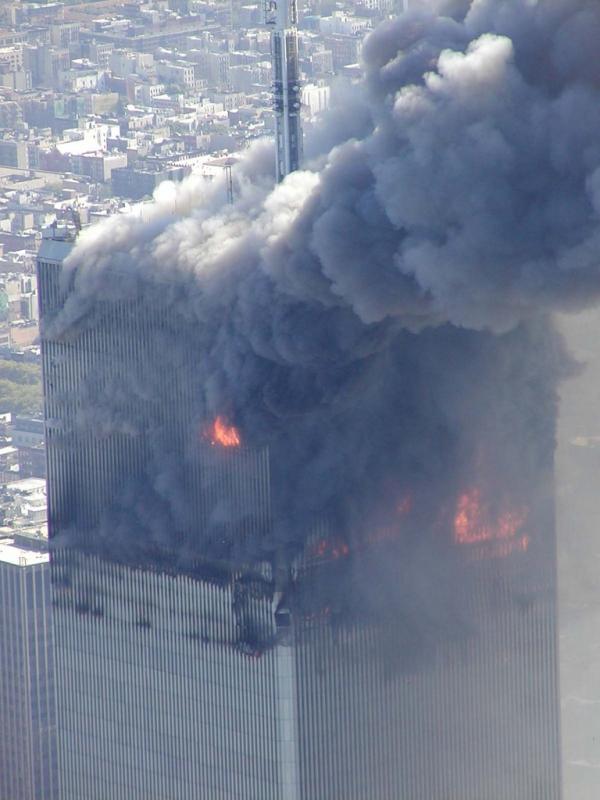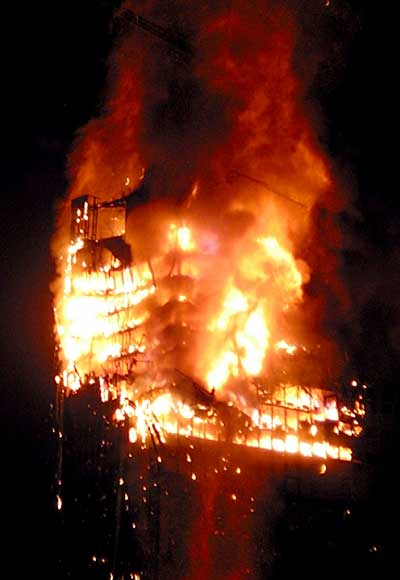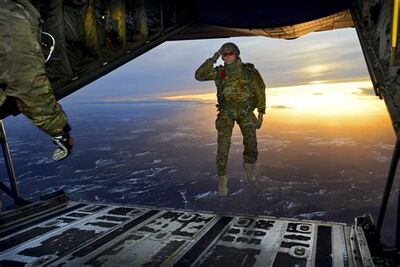Scientific proof that the three towers on 9/11 were brought down by controlled demolition.
Feb 2, 2016 17:05:57 #
payne1000 wrote:
You failed to address what caused the "blowout" shown in the photo. Force of gravity is straight down. If you haven't watched this then please do. http://www.youtube.com/watch?v=FvuKUmK9eB0
The blow out shown, in this supposed photo, could have been cause by the upper floors collapsing down to the floors where the jet crashed. Just like when a rock is dropped upon water the force expands outward and down. As far as the difference in the towers and the other building in the video collapsing the towers had greater steel girders in the lower floors and as the floors were added the steel structure was reduced so the upper floors were constructed of lighter steel girders because of their height. The other building was not nearly as tall and thus would collapse at a greater speed and none of the supporting structure was as dense as that in the towers.
Feb 2, 2016 17:31:32 #
Louie27 wrote:
The blow out shown, in this supposed photo, could ... (show quote)
You didn't watch the video. Architect Richard Gage explained why what you are claiming is pure bullshit. He shows that the top 15 floors of the North Tower disintegrates before it reaches the 90 undamaged floors. There is nothing left to crush the floors below.
Feb 2, 2016 19:04:36 #
payne1000 wrote:
You didn't watch the video. Architect Richard Gage explained why what you are claiming is pure bullshit. He shows that the top 15 floors of the North Tower disintegrates before it reaches the 90 undamaged floors. There is nothing left to crush the floors below.
That video was a fabrication of the truth it was not the actual video of the tower coming down to what I saw on tv that day.
Feb 2, 2016 19:12:13 #
Louie27 wrote:
That video was a fabrication of the truth it was not the actual video of the tower coming down to what I saw on tv that day.
There were many video cameras trained on the North Tower that day. The video Richard Gage shows has not been manipulated. It shows very accurately that the top 15 floors were disintegrated before they ever reached the undamaged 90 floors below them. The video shows even more how ridiculous your "rock falling in water" theory is.
Feb 2, 2016 19:41:15 #
Louie27 wrote:
So what does that have to say for you. Your believ... (show quote)
_____________________________________________________________
Louie 27; I consider you a friend because you post on this board. I happen not to agree with your assessment because of my engineering background. I studied several courses in college while acquiring credits towards my engineering degree that focused on 'strengths of materials'. These courses are also called mechanics of materials, is a subject which deals with the behavior of solid objects subject to stresses and strains.These courses included relative strengths.....compression, tensile, torsion, melting points, moments of deflection and 6 other stresses.
JP4 or JP5 jet fuel are both highly refined forms of kerosene, with additives inserted into these fuels to enhance ignition, and prevent gelling from temperatures. These fuels ignite and burn at a temperature of around 1700 to 1780 degrees Fahrenheit. Core 10 steel (structural steel beams used in the construction of high rise buildings will soften and melt at temperatures of around 2700 to 2800 degrees Fahrenheit. Please explain to me, in a rational manner, how JP4 or JP5 jet fuel can soften and melt core 10 steel beams in a sufficient manner to allow a high rise superstructure to collapse within its own footprint. I will look forward to your explaination! Thank you!
Feb 2, 2016 19:54:08 #
ninetogo wrote:
__________________________________________________... (show quote)
Check It out....http://www.engineeringtoolbox.com/young-modulus-d_773.html
Feb 2, 2016 20:13:53 #
ninetogo wrote:
__________________________________________________... (show quote)
I believe the structural steel used in the WTC ranged from A36 or 36000 psi to A100- 100000psi ...Cor-Ten is a weathering steel or highly corrosion resistant not sure if was used structurally in the WTC but I will check
Feb 2, 2016 20:34:21 #
emarine wrote:
Check It out....http://www.engineeringtoolbox.com/young-modulus-d_773.html
this may be better...
Steel loses strength when heated sufficiently. The critical temperature of a steel member is the temperature at which it cannot safely support its load. Building codes and structural engineering standard practice defines different critical temperatures depending on the structural element type, configuration, orientation, and loading characteristics. The critical temperature is often considered the temperature at which its yield stress has been reduced to 60% of the room temperature yield stress.[15] In order to determine the fire resistance rating of a steel member, accepted calculations practice can be used,[16] or a fire test can be performed, the critical temperature of which is set by the standard accepted to the Authority Having Jurisdiction, such as a building code. In Japan, this is below 400 °C[citation needed]. In China, Europe and North America (e.g., ASTM E-119), this is approximately 10001300 °F[17] (530-810 °C). The time it takes for the steel element that is being tested to reach the temperature set by the test standard determines the duration of the fire-resistance rating. Heat transfer to the steel can be slowed by the use of fireproofing materials, thus limiting steel temperature. Common fireproofing methods for structural steel include intumescent, endothermic, and plaster coatings as well as drywall, calcium silicate cladding, and mineral wool insulating blankets.[18]
Concrete building structures often meet code required fire-resistance ratings, as the concrete thickness over the steel rebar provides sufficient fire resistance. However, concrete can be subject to spalling, particularly if it has an elevated moisture content. Although additional fireproofing is not often applied to concrete building structures, it is sometimes used in traffic tunnels and locations where a hydrocarbon fuel fire is more likely, as flammable liquid fires provides more heat to the structural element as compared to a fire involving ordinary combustibles during the same fire period. Structural steel fireproofing materials include intumescent, endothermic and plaster coatings as well as drywall, calcium silicate cladding, and mineral or high temperature insulation wool blankets. Attention is given to connections, as the thermal expansion of structural elements can compromise fire-resistance rated assemblies
Feb 3, 2016 09:14:04 #
ninetogo wrote:
__________________________________________________... (show quote)
Good to see someone commenting who lives in a world where real science and physics applies. You have really ruined emarine's day. He's already in a three reply panic to your post.
One point you may want to reconsider--Towers 1 and 2 did not collapse into their footprints. 80% to 90% of each was ejected hundreds of feet outside the footprints.
Feb 3, 2016 10:36:08 #
ninetogo wrote:
__________________________________________________... (show quote)
A engineer at the American institute of steel construction say that at 1100 degrees F steel will soften bend and twist because it loses 50% of its strength at that temperature. It is also thought that the temperature probably reached approximately 1832 degrees with all of the furniture, rugs and miss. products in the building and that would bring the steel down to about 10% of its initial strength. AS for the upper stories disentigrating before they reach the floors where the plane crashed, there is a picture or those upper floors intact and falling downward. at an angle and the add weight on those floors would cause the collapse.
Feb 3, 2016 11:20:13 #
Louie27 wrote:
A engineer at the American institute of steel cons... (show quote)
The photo you are referring to was the South Tower--not the North Tower which was shown in the Richard Gage video. The upper section of the South Tower also disintegrated (was blown to bits) before it hit the ground.
Metal turns red when it reaches 1100 degrees. Do you see any red metal here?


Feb 3, 2016 13:18:35 #
Louie27 wrote:
What you will find here, Louie, is far beyond the mental abilities of 911 truthers.A engineer at the American institute of steel cons... (show quote)
World Trade Center Evidence-based Research
North Tower


Feb 3, 2016 13:43:22 #
Blade_Runner wrote:
What you will find here, Louie, is far beyond the mental abilities of 911 truthers.
World Trade Center Evidence-based Research
World Trade Center Evidence-based Research
Why didn't you reply to Ninetogo, BR? Would an exchange with a real engineer be too far above your pay grade?
I see you're still posting those photos in which the fire has been intensified in Photoshop. And you're still posting that cover-up site where the author is one person who won't give his name or his scientific credentials.
Here's a person with impeccable credentials and he says your claims are bullshit and traitorous.
http://www.youtube.com/watch?v=x_4X8OVL5vo
Feb 3, 2016 16:56:05 #
payne1000 wrote:
The photo you are referring to was the South Tower--not the North Tower which was shown in the Richard Gage video. The upper section of the South Tower also disintegrated (was blown to bits) before it hit the ground.
No! Because most of the fire was in the center of the building where it stopped. Smoke rose up the elevator shafts, from the fire, and fire rained down the elevator shafts to the main floor where a number of people wre killed and burned. I also said the metal lost its strength when at those temperatures and would collapse. I lot of the support for these skyscrapers was was bolted to the inner core of the building and the destruction of those supports could cause a great problem. I guess you will not believe anything that has been shown from actual footage of the buildings when they started to collapse. I suppose by your theory that the planes set off the explosives on that floor. That was a real coincidence for those so called charges to go off at that time. I guess no one will be able to prove to you they fell because of the planes striking the buildings.
Feb 3, 2016 17:02:35 #
Louie27 wrote:
No! Because most of the fire was in the center of ... (show quote)
Louie, you're not making any sense at all. Here are some questions that you and all the other official "conspiracy theory" supporters can't answer:

This fire burned for over 20 hours and caused a partial collapse on the top floors. The debris from the partial collapse fell straight down. The partial collapse happened gradually over a period of hours, not instantly and total as happened on 9/11.

If you want to reply, then register here. Registration is free and your account is created instantly, so you can post right away.


